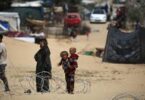F.P. Report
VIENNA: In 2020, cancer killed nearly 10 million people, and new cancer cases are predicted to rise to between 29 and 37 million per year by 2040 unless dramatic action is taken, according to the International Agency for Research on Cancer. Addressing this challenge, and the tremendous burden cancer exerts physically, emotionally and financially on individuals, families, societies and health systems, will require building more cancer treatment facilities and rethinking the way the world tackles this disease.
A new joint publication, Setting up a Cancer Centre: A WHO–IAEA Framework, by the IAEA and the World Health Organization (WHO), will help by guiding policymakers, programme managers and clinical care providers in setting up and developing cancer treatment facilities in a phased manner. The guidance document supports the approach already established under the joint IAEA–WHO publication Roadmap towards a National Cancer Control Programme: Milestones for establishing nuclear medicine, diagnostic imaging and radiotherapy services.
“The world is facing an ever-growing cancer epidemic, and our cancer facilities are on the front line of this battle,” said May Abdel-Wahab, Director of the IAEA’s Division of Human Health. “The guidance document is a valuable tool in the planning and implementation of cancer centres, providing guidance on setting up different levels of cancer services within individual cancer centres. The ultimate goal is to improve the level of cancer services through a stepwise approach, providing context and requirements for specific services.”
This guidance is intended to cover multidisciplinary cancer care, and details the infrastructure, human resources and equipment needed for oncological and supportive care services, she said.
Facilities to tackle cancer
Cancer centres are facilities primarily for providing cancer care, but they are also essential for creating and implementing new treatment evidence through research and education, and provide guidance on all aspects of cancer within a country. While access to cancer centres varies widely around the world, such facilities are recognized as a critical part of the health care system when developing a cancer control strategy.
Cancer centres provide services relating to cancer prevention, diagnosis, multidisciplinary treatment, supportive care, research and education. The extent to which these services are provided depends on the local context, and they are constantly evolving to meet the demands of the cancer burden.
The capacity to prevent cancer and control the cancer burden is not equal between and within countries. In countries with underdeveloped health systems and limited resources, there is limited access to diagnosis and treatment. Furthermore, there are major deficits in the provision of cancer services, from prevention to survivorship care.
In 2019, for example, only 26 per cent of low income countries around the world reported having public sector pathology services for diagnosing cancer, and only 30 per cent of these countries had cancer treatment services. However, 90 per cent of high income countries could offer such services.
“The consequences of this insufficient capacity mean late diagnosis of cancer, suboptimal cancer care, poor outcomes and high out-of-pocket expenditure,” said Cherian Varghese, coordinator for non-communicable diseases and special initiatives at the WHO. “Other consequences include the failure to achieve global targets, including reduction in premature mortality from non-communicable diseases, as outlined in the Global Action Plan for the Prevention and Control of Noncommunicable Diseases.”






